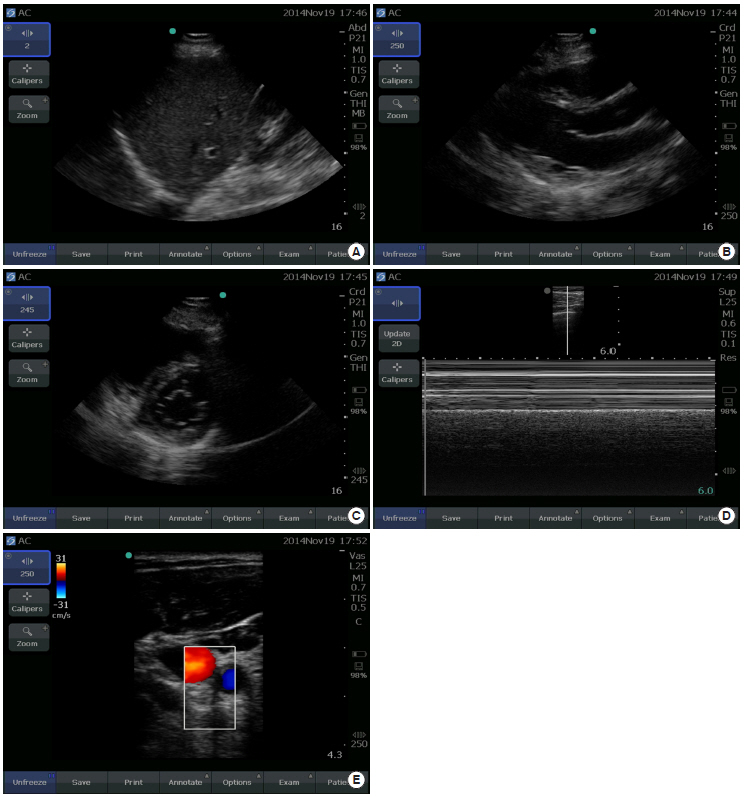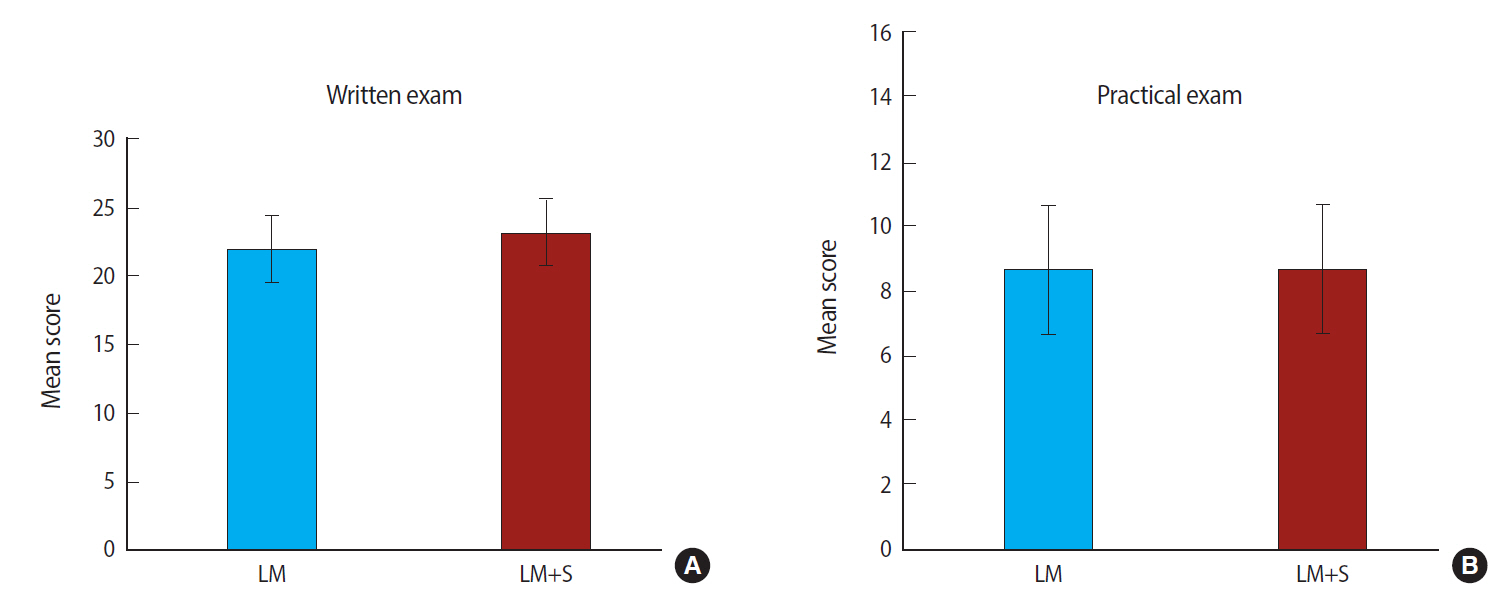J Educ Eval Health Prof.
2016;13:16. 10.3352/jeehp.2016.13.16.
Randomized study of effectiveness of computerized ultrasound simulators for an introductory course for residents in Brazil
- Affiliations
-
- 1Department of Medicine, University of California Irvine School of Medicine, Irvine, CA, USA. jpsilva@uci.edu
- 2Department of Internal Medicine, Hospital de Clinicas de Porto Alegre, Porto Alegre, Brazil.
- KMID: 2413765
- DOI: http://doi.org/10.3352/jeehp.2016.13.16
Abstract
- PURPOSE
This study aimed to assess the impact of ultrasound simulation (SonoSim) on educational outcomes of an introductory point-of-care ultrasound course compared to hands-on training with live models alone.
METHODS
Fifty-three internal medicine residents without ultrasound experience were randomly assigned to control or experimental groups. They participated in an introductory point-of-care ultrasound course covering eight topics in eight sessions from June 23, 2014 until July 18, 2014. Both participated in lecture and hands-on training, but experimental group received an hour of computerized simulator training instead of a second hour of hands-on training. We assessed clinical knowledge and image acquisition with written multiple-choice and practical exams, respectively. Of the 53 enrolled, 40 participants (75.5%) completed the course and all testing.
RESULTS
For the 30-item written exam, mean score of the experimental group was 23.1±3.4 (n=21) vs. 21.8±4.8 (n=19), (P>0 .05). For the practical exam, mean score for both groups was 8.7 out of 16 (P>0 .05).
CONCLUSION
The substitution of eight hours of ultrasound simulation training for live model scanning in a 24 hour training course did not enhance performance on written and image acquisition tests in an introductory ultrasound course for residents. This result suggests that ultrasound simulation technology used as a substitute for live model training on an hour-for-hour basis, did not improve learning outcomes. Further investigation into simulation as a total replacement for live model training will provide a clearer picture of the efficacy of ultrasound simulators in medical education.
MeSH Terms
Figure
Reference
-
References
1. Sippel S, Muruganandan K, Levine A, Shah S. Review article: use of ultrasound in the developing world. Int J Emerg Med. 2011; 4:72. http://dx.doi.org/10.1186/1865-1380-4-72.
Article2. Fernandez-Frackelton M, Peterson M, Lewis RJ, Perez JE, Coates WC. A bedside ultrasound curriculum for medical students: prospective evaluation of skill acquisition. Teach Learn Med. 2007; 19:14–19. http://dx.doi.org/10.1080/10401330709336618.
Article3. Hoppmann R, Cook T, Hunt P, Fowler S, Paulman L, Wells J, Richeson N, Thomas L, Wilson B, Neuffer F. Ultrasound in medical education: a vertical curriculum at the University of South Carolina School of Medicine. J S C Med Assoc. 2006; 102:330–334.4. Akaike M, Fukutomi M, Nagamune M, Fujimoto A, Tsuji A, Ishida K, Iwata T. Simulation-based medical education in clinical skills laboratory. J Med Invest. 2012; 59:28–35. http://dx.doi.org/10.2152/jmi.59.28.
Article5. SonoSim. The SonoSim Ultrasound Training Solution [Internet]. Santa Monica (CA): SonoSim Inc.;2012. [cited 2014 Sep 15]. Available from: http://sonosim.com/our-solution.6. Cook DA, Hatala R, Brydges R, Zendejas B, Szostek JH, Wang AT, Erwin PJ, Hamstra SJ. Technology-enhanced simulation for health professions education: a systematic review and meta-analysis. JAMA. 2011; 306:978–988. http://dx.doi.org/10.1001/jama.2011.1234.
Article7. Maddox RW, Schmid RJ. New frontiers in medical education: simulation technology at Campbell University School of Osteopathic Medicine. N C Med J. 2014; 75:59–61. http://dx.doi.org/10.18043/ncm.75.1.59.8. Chung GK, Gyllenhammer RG, Baker EL, Savitsky E. Effects of simulation-based practice on focused assessment with sonography for trauma (FAST) window identification, acquisition, and diagnosis. Mil Med. 2013; 178(10 Supple):87–97. http://dx.doi.org/10.7205/MILMED-D-13-00208.
Article9. Maul H, Scharf A, Baier P, Wustemann M, Günter HH, Gebauer G, Sohn C. Ultrasound simulators: experience with the SonoTrainer and comparative review of other training systems. Ultrasound Obstet Gynecol. 2004; 24:581–585. http://dx.doi.org/0.1002/uog.1119.
Article10. Sidhu HS, Olubaniyi BO, Bhatnagar G, Shuen V, Dubbins P. Role of simulation-based education in ultrasound practice training. J Ultrasound Med. 2012; 31:785–791.
Article11. Fox JC, Chiem AT, Rooney KP, Maldonaldo G. Web-based lectures, peer instruction and ultrasound-integrated medical education. Med Educ. 2012; 46:1109–1110. http://dx.doi.org/10.1111/medu.12039.
Article
- Full Text Links
- Actions
-
Cited
- CITED
-
- Close
- Share
- Similar articles
-
- Impact of 8-Week Bedside Ultrasound Training for Surgical Residents in the Intensive Care Unit of a Tertiary Care Hospital - a Pilot Study
- The effect of repetition of simulation-based cardiopulmonary resuscitation training on the satisfaction of the trainee
- Thyroid Ultrasound: Change of Inter-observer Variability and Diagnostic Performance after Training
- Benefits of a resident-run orientation for new radiology trainees
- Virtual reality simulators for temporal bone dissection: overcoming limitations of previous models



